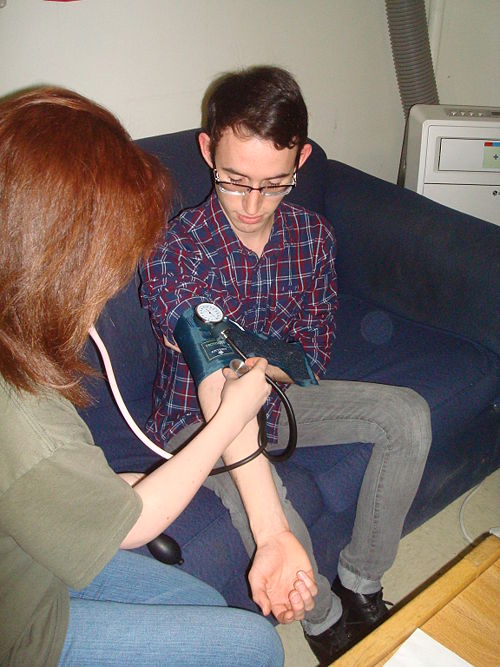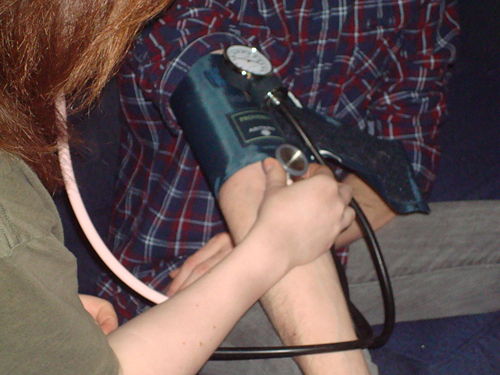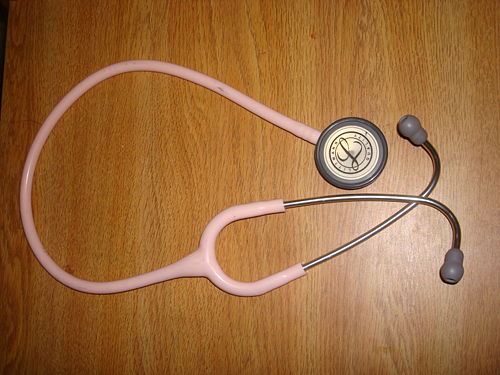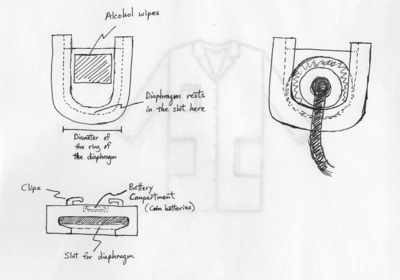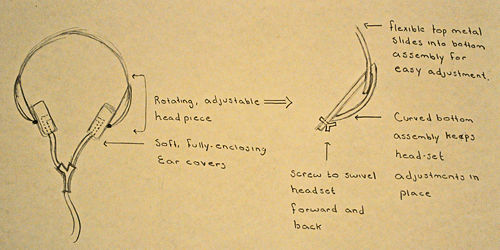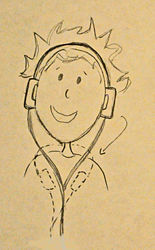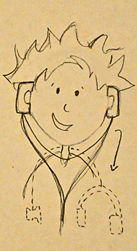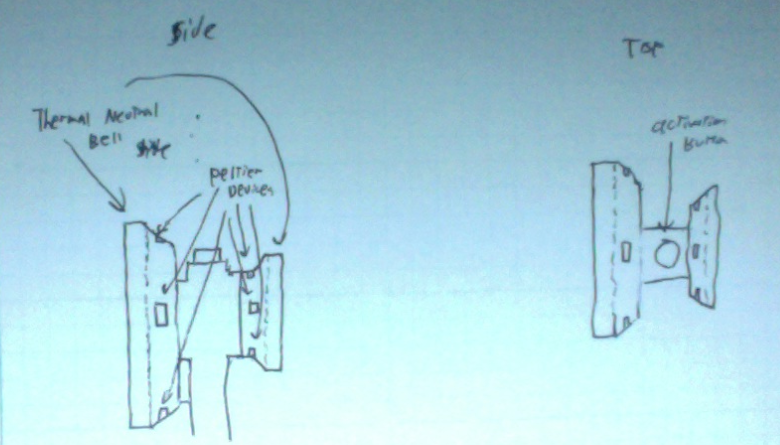Stethoscope opportunity
From DDL Wiki
(→Pugh Chart (Jake)) |
(→Design 3: Peltier heated stethoscope head) |
||
| Line 130: | Line 130: | ||
===Design 3: Peltier heated stethoscope head=== | ===Design 3: Peltier heated stethoscope head=== | ||
| - | + | Through our market research, we learned that patients consistently complain that the stethoscope is too cold when it touches their bare chest or arm. If order to reconcile this, a heating device (peltier cells) could be added to the head of the stethoscope. Given the right current, the air could heat up, causing the head of the stethoscope to heat up to a warm temperature. To ensure it doesn't get too hot, and potentially burn either the patient or the health care provider, the ring holding the drum in place will be replaced with a rubber material. | |
| - | + | ||
| - | + | ||
| - | : | + | [[Image:Stethoscope_Peltier_Draft_Corrected.png]] |
==Competitor Products Research== | ==Competitor Products Research== | ||
Revision as of 13:59, 26 February 2012
Contents |
Group Information
24-441 Spring 2012, Group 3
Kellen Chow (Team Leader with the new hair cut)
Jacob Divone (EMT with the puking guts)
KinHang Leung (Brainstorming Facilitator with the weird balloon animals)
Cecily Sunday (Charts Specialist with the sweet grandma)
Report 2 - Opportunity: Market Research and Design Concepts
Executive Summary
Market Research and Observations
Use Study Observations
Image:Stethoscope-LungSounds1.JPG
User Interview Questions
In order to determine stakeholder needs we conducted user interviews using the following set of questions:
Choosing the Product
- How did you select which stethoscope to buy?
- How did you research your options?
- What factors played the biggest role in your choice?
Using the product
- How were you taught to use this equipment (in a class, on the job, etc.)?
- Do you warm up, clean the face of, or do anything else to the stethoscope prior to using it on a patient?
- Does your stethoscope perform equally well in all conditions (temperatures, background noises, etc.)?
- How often do you buy a new stethoscope? Why do you buy a new one?
- What type of maintenance operations do you perform on your stethoscope?
- How do you carry the stethoscope and why (around neck, in pocket, etc.)?
Suggestions for Improvement
- What don't you like about this product?
- How would you suggest improving this product?
Highlights from User Interviews
Our interviewees included the following people, all stakeholders:
- Trauma Surgeon
- Clinician
- Retired Nurse
- Nurse with 3 years of experience
- 1st year Medical Student
- Medical Intern
Stethoscope selection
- Hospitals supply cheaper ones or at a discount
- Need easy replacements and low cost (especially for medical student)
- Ear comfort very important
- Littman very durable and has replaceable parts
- High sound quality important
- Asking around lets you know which brands are useful
- Determine:
- Type of patient working on (human vs. animal)
- Size of patient (child vs. adult)
- Listening to specific organ (heart, lung, etc.)
- Aesthetics
- Likelihood of loss or theft
Stethoscope Use
- Used cheap ones until figured out what assigned environment and specialty
- Carry in pocket, around neck if no pocket
- Wipe down earbuds with alcohol wipes
- Rarely clean tubes and diaphragms
- Rub diaphragm with palm to make warmer
- Wash bell with ETOH swab after every day
- Patients in isolation have special stethoscopes that do not leave their room
Difficulties and Problems
- Difficult to hear in loud ambient noise (e.g. loud emergency room)
- Hairy surface causes unwanted noise
- Harder to examine larger people
- Problem with diaphragm cracking and drying up
- Extra weight on neck causes discomfort
- Carrying in pocket causes stethoscope to hit obstacles while walking
- Stethoscope heads are rarely cleaned
- Heavy and cumbersome, especially on double tube designs
- Can get caught in hair and gets in the way when on the phone
- Ambient noise very big problem, esp. in ER or even with A/C
- Earbud angle is very awkward and uncomfortable
- Electronically amplified stethoscopes are bulky and awkward to store and use
Suggestions for Improvement
- Warmer for diaphragm
- More comfortable earbuds
- Overall reduced mass
- Clip on lab coat for stethoscope
- Snap-on earbuds instead of screw-on
- Amplify diaphragm or top of tubes
- Abnormality indicators
- Antibacterial surface on bell
- Noise-cancelling headphones or earbuds
Top Stakeholder Product Needs (Kellen)
Our Top 3 Design Concepts
Design 1: Coat Integration with Heater and Sanitizer
Potential Design Opportunities:
- Integration should not affect the manufacturing of the coat; the design should focus on making mechanisms on the stethoscope that would easily attach to an average doctor's coat.
- Integrating the tubes inside/under the collar - What kind of attachment mechanism...Pins? Velcro? Adhesive? Clips?
- Mounting the heating/sanitizing holder on the chest area of the coat - What kind of attachment mechanism...Safety Pins? Clip? Velcro?
- Alternate material selection for a light-weight design
- Designing the appropriate and low-cost heating element - Drawing heat from user's body? Battery-powered?
- Designing the sanitizing element - Alcohol patches in the holder must be easily replaceable
Design 2: Headset Redesign
During user interviews, numerous complaints arose in association with the stethoscope's headpiece. In order to hear properly, the holes in the ear pieces should be directly aligned with the user’s ear canals. However, this task is made difficult by the stiff body of the full headset and the often un-customized size of the ear buds. In environments with extraneous background noise, medical professional must often hold the headset in place with one hand with using the other to place the chest piece. Other issues associated with the headset include general discomfort, problems with the ear buds unscrewing and getting lost, and cracked or dried-out ear pieces due to frequent cleaning with alcohol wipes.
Design 3: Peltier heated stethoscope head
Through our market research, we learned that patients consistently complain that the stethoscope is too cold when it touches their bare chest or arm. If order to reconcile this, a heating device (peltier cells) could be added to the head of the stethoscope. Given the right current, the air could heat up, causing the head of the stethoscope to heat up to a warm temperature. To ensure it doesn't get too hot, and potentially burn either the patient or the health care provider, the ring holding the drum in place will be replaced with a rubber material.
Competitor Products Research
Pugh Chart (Jake)
| Design 1: Coat Integration | Design 2: Headset Redesign | Design 3: Peltier Heating Method | Design 4: Abnormality Indicator | Design 5: Retractable Tubing | |||
|---|---|---|---|---|---|---|---|
| Criteria | Weight | Datum | |||||
| ease of use | |||||||
| comfort | |||||||
| noise transduction | |||||||
| noise cancelation | |||||||
| safety | |||||||
| manufacturability | |||||||
| portability | |||||||
| durability | |||||||
| durability | |||||||
| sanitation | |||||||
| aesthetics | |||||||
| Weighted Total |
Gantt Chart (Kin)
Summary and Recommendations
Appendix (100 ideas)
I organized these...but i have the original list if we prefer those. do you think there is a way to carry over the numbers?...
Air-tube Alternatives
- Water filled tubes
- Alcohol filled tubes
- Oil filled tubes
- Replace air-filled tubes by electronic wires (headphones cables)
- Retractable stethoscope tubing
Headset Alternatives
- Snap-on earbuds instead of screwed-on
- Noise-cancelling headphones
- Noise-cancelling earbuds
- Extendable tubes for better reach
- Rubber earpieces
- Silicone earpieces
- Sleep plug earpieces
- Ear cover earpieces
- Bose styled head set
- gel filled ear pieces
- adjustable triple leaf spring
- suction cup ear muffs
- adjustable head band connecting ear pieces
Chestpiece Alternatives
- Snap-on Diaphragm
- Aperture style diaphragm
- Disposable diaphragm surface/film
- A diaphragm heater using Peltier cells
- Replace diaphragm material with self-sanitizing brass
- Sonar sensor integrated on the diaphragm
- Adjustable drum
- Changing tribology of the drum to lower noise produced from sheer forces
Stethoscope Integration Products
- Blood pressure cuff interface
- Diaphragm heater and holder integrated on coat (battery)
- Alcohol Pouch integrated on coat
- Coat pouch/clip around the chest area
- A coat pouch/holder that heats and cleans the diaphragm
- Integrating tubes in the coat sleeve and the diaphragm in the cuff
- Hugging stethoscope coat (integrated in the coat so user hugs the patient during use)
- Integrating a heart rate monitor on chestpiece
- Integrating a murmuring sound indicator on chestpiece
- A hand-held separate heart rate monitor (connects to chestpiece by wire)
- A hand-held separate heart rate monitor (Bluetooth)
- Bluetooth connection to user's mobile device (like an app)
- Integration of a respiratory rate indicator
- Integrate visual display of sound
- Integrated with pulse oximeter
- integrating recordable lung sounds
- integrated timer stethoscope
Other Ideas
- Hooked up to visual display on eyeglasses
- Integration of the stethoscope on dummies that create sounds for medical training
- Heated fluid in stethoscope for comfort
- speaker output stethoscope
- speaker integration stethoscope
- broadcasting noise for training purposes
- golf ball cleaning system
- air blasting cleaning system
- magnetic stethoscope holder
- amplification through mechanical resonance
- Bio-inspired sound amplification using inner ear drum
- Signal processor at junction
- Heated stethoscope holster to keep stethoscope at comfortable temp
- Break away security system
- Stethoscope flashlight
- Remove metal to ensure stethoscope doesn't get cold
